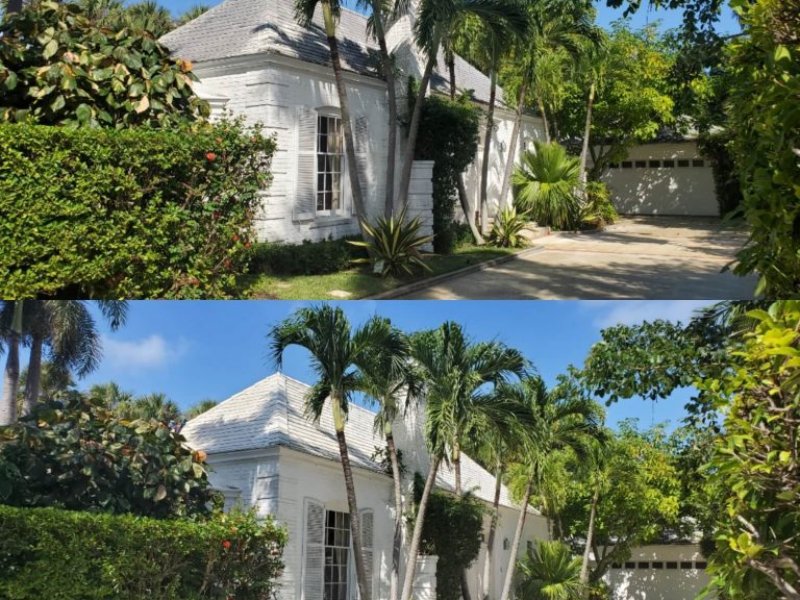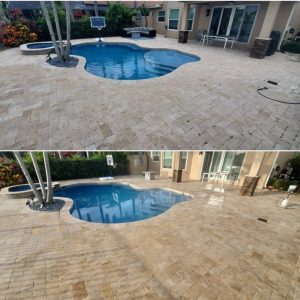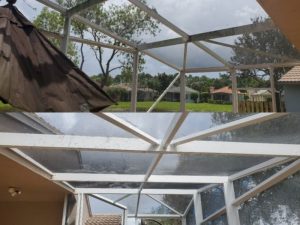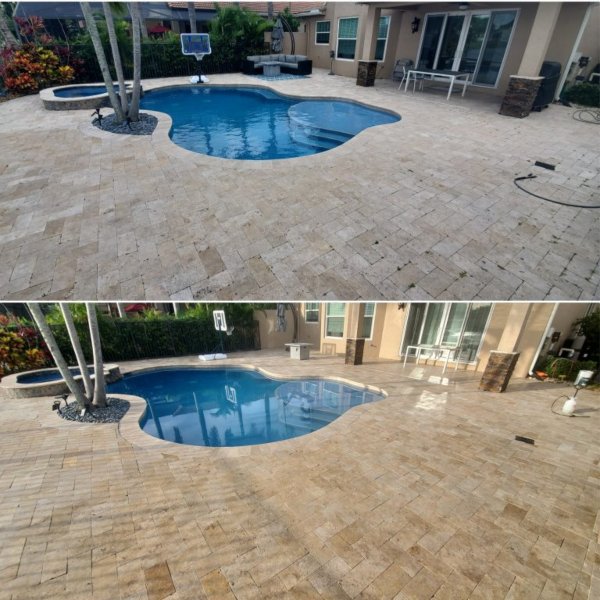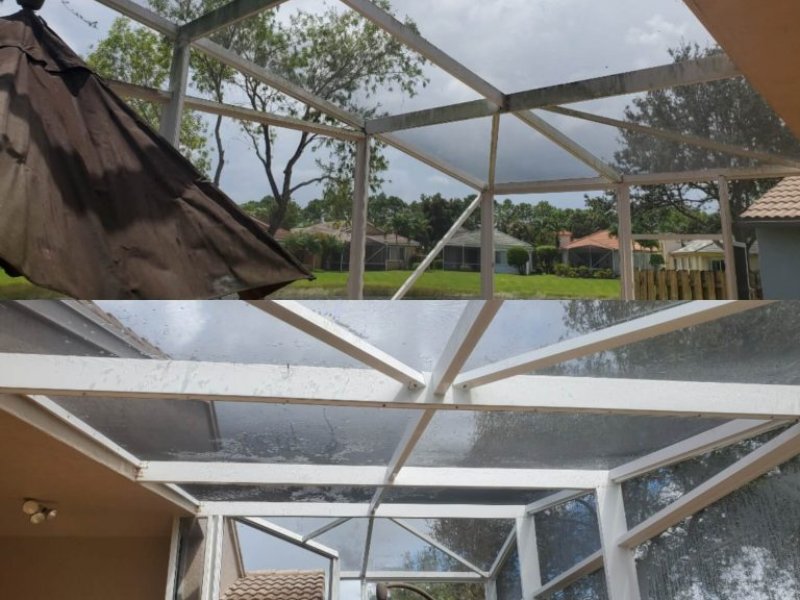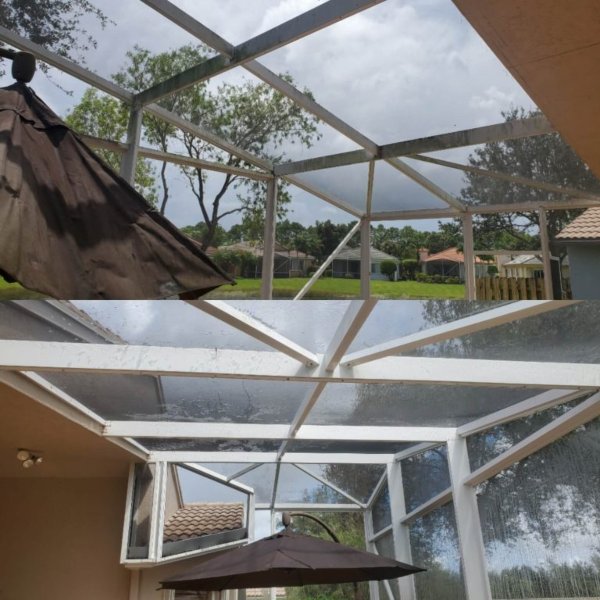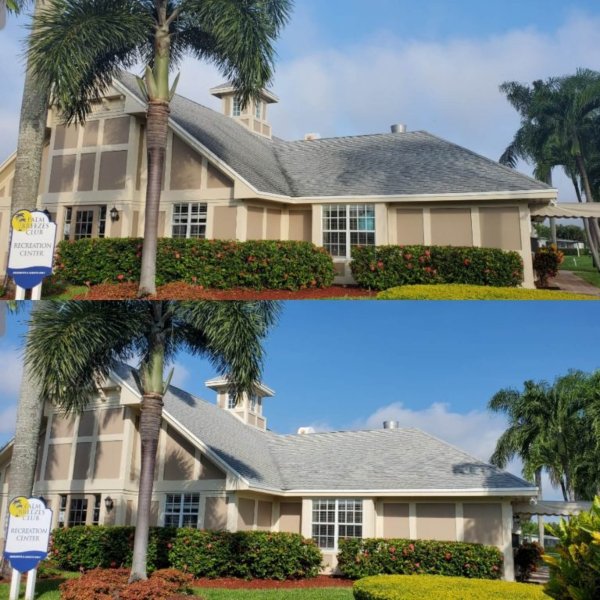You want a clean, healthy home exterior—but you don’t want damage, streaks, or dead plants. At Oleyn’s, we get it. If you live in Lake Worth, FL, you’re fighting year-round humidity, coastal salt, and storm seasons that feed algae, mildew, and grime. This quick guide explains what’s growing on your home, the safest way to wash it, how often to do it, and why choosing a pro matters.
What’s actually on your siding (and why Florida homes see it faster)
In our subtropical climate, airborne spores settle on shaded, damp surfaces and flourish. Algae and mildew show up as green film on siding and soffits; on roofs, the tell-tale black streaks often come from the algae Gloeocapsa magma. Left alone, biological growth holds moisture against surfaces, shortening paint life and accelerating deterioration. Routine, low-pressure cleaning knocks it back safely and extends the life of your exterior finishes.
Soft washing vs. pressure washing (and why “gentle” wins for homes)
“Power” isn’t the point—control is. On siding, stucco, trim, and soffits, high PSI can force water behind panels, scar paint, or etch delicate finishes. Soft washing uses low pressure, combined with detergents that break down grime and kill biological growth, allowing for gentle and thorough rinsing. It’s the preferred approach for most home exteriors and windows; we reserve higher pressure for hardscapes, such as concrete, where it’s appropriate.
What a safe, professional house wash looks like
Here’s the Oleyn’s checklist so you know what “good” looks like:
- Protect & prep
We cover or pre-wet plants and landscaping, move furniture, and tape outlets. Protecting vegetation and fixtures is non-negotiable in a chlorine-prone environment. - Right chemistry, right dwell time
For organic growth (algae/mildew), solutions that include sodium hypochlorite (household bleach) plus surfactants are proven effective when applied correctly and allowed to dwell briefly before a low-pressure rinse. Ratios vary by surface and soil load; the key is controlled application and thorough rinse, not brute force. - Low-pressure application
We use wide-fan tips and gentle rinsing on siding, soffits, and painted trim. The aim is a uniform, streak-free finish without driving water where it shouldn’t go. - Environmental compliance
According to Be River Friendly, wash water that contains detergents or debris should never be allowed to run into storm drains. We manage runoff on-site to protect local waterways—an important step under stormwater best practices. - Quality control walk-through
After rinsing, we spot-treat stubborn areas, check windows and seals, and ensure plants are re-watered and neutralized as needed.
How often should you wash in Lake Worth?
Most homes benefit from a yearly soft wash; shaded elevations or homes near trees may need light touch-ups sooner. In humid climates, annual cleaning helps prevent buildup, protects paint and caulk, and maintains curb appeal—especially important before and after storm season.
Will house washing hurt my paint, stucco, or vinyl?
Done correctly, no. Problems come from excessive PSI, harsh nozzles, or letting chemicals dry on the surface. We match pressure and cleaners to the material (wood and vinyl need gentler handling; concrete tolerates more), keep solutions wet during dwell, and rinse thoroughly—approaches recommended by home-care pros and building-product experts.
What about the roof?
While this guide focuses on siding and trim, many homeowners ask about those black roof streaks. The Asphalt Roofing Manufacturers Association (ARMA) recommends low-pressure rinsing and a diluted bleach solution—not high pressure—which is the standard we follow when treating appropriate roofing materials.
Is bleach safe around my landscaping?
Used responsibly, yes. The key is professional dilution, targeted application, keeping chemistry wet only on the building surface, and heavy pre- and post-watering of plants (plus neutralization when warranted). UF/IFAS guidance notes that mild cleaners can address light growth; bleach-based solutions are reserved for killing stubborn mold and mildew, with careful rinsing afterward.
DIY or hire it out?
If you’re experienced and working on a single-story section with proper gear, DIY can be feasible—but avoid high pressure on siding, watch wind drift, protect plants, and never let detergents reach drains. For most Lake Worth homes—especially multi-story, delicate finishes, or heavy growth—a professional soft-wash service is safer and more effective (and usually faster), with the right equipment, chemistry, and runoff controls.
The Oleyn’s 3-step plan
- Assessment & quote – We inspect materials, stains, and risk areas, then tailor chemistry and techniques to your home.
- Plant & property protection – Covering, pre-wetting, and safe containment keep your landscaping and hardscape happy.
- Soft wash service – Low-pressure application, timed dwell, and meticulous rinsing deliver a like-new finish—guaranteed.
FAQs
How long does it last?
Most homes stay fresh 9–12 months; shaded or windward sides can vary. Annual maintenance keeps growth from anchoring.
Will it help my paint last?
Yes—removing grime and growth reduces trapped moisture and extends coating life, a core principle in exterior maintenance.
Is house washing safe near the Intracoastal?
Yes, when runoff is contained and chemistry is controlled. We follow stormwater BMPs to keep wash water out of drains and waterways.
Ready for a home that looks freshly painted—without the paint?
If you’re in Lake Worth, FL, Oleyn’s is your local soft-washing specialist. We combine science-based cleaning, plant-safe practices, and Gulf Coast weather know-how to protect your home and boost your curb appeal.

